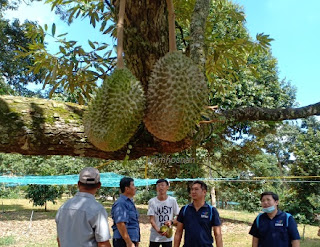Talking about the durian boom and the way of durian for the plantation and its fruit production is an interesting topic. Durian can grow and fructify in a high-temperature climate. The time of fruit production is different depending on the variety. Light species usually fructify after 4 to 5 years, and common species generally fructify in 6-8 years. Dense species produce typically results in about eight years, and fructify once a year. The maturity time differs by 1 to 2 months. It takes 7-10 years for the former plantation of the durian tree to start fruit production. However, most of the durians are grafted now in which the tree body is not so tall, and the fruit production period is earlier to 4-5 years after planting. Most durian trees are more than 20 meters high, and the distance between fruit trees and fruit trees must be at least thirty feet. Trees that have just started to produce fruit could produce up to only 10 – 60 durian fruits each. With the age of 10 years, the fruit volume can increase to 50 – 100 durian fruits per tree, and even more trees of 20 years and above can yield up to 100-200 durian fruits. Durian can be divided into three types of land: flat land, slope, and hills. The durians in the hills are better than the slopes, and the durians on the slopes are better than the flat grounds. Because the air in the high mountains is relatively clean and less polluting, and the rain is abundant. The mentioned kind of temperature is more suitable for the growth of durian trees; the quality of the durians is better. Those planted durians in the mountain are more sun-drenched, so the durian shells are usually gray.
For the durian plantation the seeding can be done every year, and when the seedlings are 30-40 cm high and they can be planted on land in soil. Durian can be divided into two types, one is the origin and the other is grafted. For example for the source of Musang King (D197) at Sungai Ruan, Bentong and Raub in Pahang are the most popular variety planted. The durian of origin is 100% pure, and its quality is better than that of grafting, so although there are same Musang King, but the durian from origin place is the best in which the price is usually higher. The immature durian has a grassy smell. The ripe durian emits an aroma and is naturally cracked, which is easy to eat. When you smell the alcohol-like odor from the durian, it must be spoiled, and you should not buy it. Most Malaysian durians fall from the tree after they mature naturally and can be stored for up to three or four days. Durian planting method are an important factors. Sometimes the 9nferior durians can produce excellent varieties. Good durian tree can produce inferior types and some real durians do not bear fruit for their whole life. The way of grafting breeding is used to cultivate durians to ensure the purity of the types which could produce a higher yield. Normally the row spacing of sowing plants should be 20cm x 20cm depending on soil slope. During seedling growth, weeding and fertilization should be paid more attention to. Superior durian mother plants can be propagated by aerial beading, and easy to strike root. It usually takes two months from the branch to the seedling. When the durian sapling grows to 30 to 40cm in which it can be planted on land. The row spacing of 3m x 5m rice is appropriate. Organic fertilizer, soil fertilizer, and the proper amount of lime are used as base fertilizer. Durian can be planted throughout the year, preferably with soil. Manuring and fertilization management of durian saplings: Fruit trees should be fertilized once a year including spring pumping fertilizer, summer fruit expansion fertilizer and pre-harvest fertilizer, especially fruit expansion fertilizer. Apply organic fertilizer once after harvesting the fruit. Farmers must pay attention to shaping and pruning: Durian tree has relatively strong germination ability, so pay attention to shaping and pruning after picking fruit after planting for one to two years. Good tree shape is more conducive to better durian quality and production.
In many way durian also has a medicinal value. Durian peel could use for boiled chicken soup with durian flesh and drink as food nourishment for women and eliminate the chilly. We could take the white part inside instead of the whole durian peeled skin. Using the durian white flesh with lean meat or chicken to cook soup, which could give you the sweet taste and help your body to reduce the heat that could get us to overheat and get sick during the hot summer. It has the functions of nourishing blood and body. Durian kernels also have a particular medicinal value, and folks often used it to practice the durian kernel soup. Compared with durian pulp, durian kernel is milder, which could dry it to cook soup that has kidney support and spleen strengthening effects. In the modern medical research shows that proteolytic enzymes extracted from durian juice and its peel can enhance the hydrolysis of fibrin in the body, at the same time dissolve blood clots and improve local circulation of body fluids, thereby eliminating inflammation and edema. It even could be used as an anti-edema and anti-inflammatory drug. Durian protease is used in combination with antibiotics and chemotherapeutics to promote drug penetration into the virus. It can be used for inflammation, edema, and thrombosis caused by various reasons, such as bronchitis, acute pneumonia, mastitis, and retinitis. According some reports that the durian peel has a better effect on senile pruritus. Thanks..!
M Anim,
Senior Agronomist,
Putrajaya,
Malaysia.
(April 2021).





Learn how to care for Thailand's Ri6 durian variety effectively and with high yield
ReplyDelete